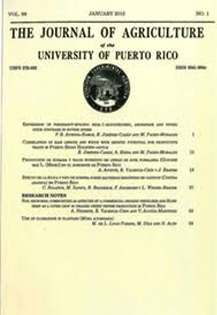Abstract
A profile of Guanajibo clay (Plinthic Kandiudults) was evaluated to determine the ironstone content in the horizons and its chemical, physical and mineralogical properties. The mineralogy was characterized by X-ray diffraction (XRD) and the iron and aluminum oxide content determined by selective dissolution, using citrate-bicarbonate dithionite (CBD) and ammonium oxalate (OX) extractions. Soil color and the color of ground ironstone were determined with Munsell color charts. Soil texture, pH, and effective cation exchange capacity (ECEC) were also evaluated. The highest content of ironstone per unit mass was found in the Ap horizon (4.6%), decreasing in the Bt (0.9%) and Btv1 (1.0%) horizons. An increase in ironstone content was observed in the Btv2 horizon (3.8%), which suggests that this horizon was formed from alluvial deposits containing ironstone. No ironstone was found in the Btv3 horizon. The texture of the Ap horizon was a sandy clay, and the other horizons had a clay texture. Clay content reached a maximum value of 92.8% in the Btv3. The ECEC was low for the whole profile, ranging from 2.37 cmolc/kg in the Ap horizon to 4.37 cmolc/kg in the Btv3 horizon. The low ECEC is indicative of mineralogy dominated by highly weathered clay minerals like kaolinite and iron and aluminum oxides. The XRD analysis confirmed the presence of kaolinite, goethite, quartz, hematite and gibbsite in the clay fraction (< 2 mm) of the soil. A small peak corresponding to 2:1 clay minerals, probably Al-hydroxy interlayer vermiculite or montmorillonite, was observed in clay samples from the Ap, Bt and Btv1 horizons. The major mineral components of the ironstone were goethite, kaolinite and quartz. The fine earth fraction (150 µm) of the Btv1 horizon had a 2.8% CBD extractable iron content and a ratio of OX/CBD less than 0.10, meeting the two requirements established by Soil Taxonomy to qualify as plinthic. The other horizons met the requirement of OX/CBD ratios of less than 0.10, but had less than 2.5% iron extractable by the CBD method. Soil management practices that prevent soil erosion must be implemented in this soil to ward off exposure of plinthite to the surface and its irreversible hardening to ironstone.

